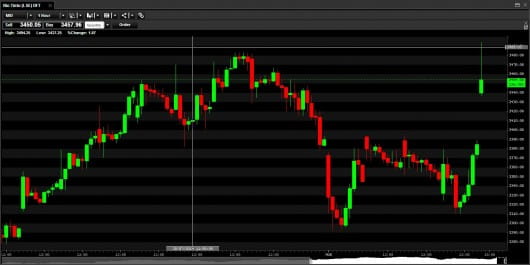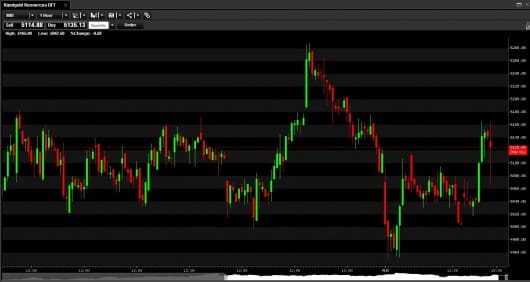Rio Tinto shares open higher as profits jump
UPDATED: 7 August, 8.02am Rio Tinto and Randgold Resources profits jumped as both firms reported their respective earnings to the market on Thursday morning. Rio […]
UPDATED: 7 August, 8.02am Rio Tinto and Randgold Resources profits jumped as both firms reported their respective earnings to the market on Thursday morning. Rio […]
Rio Tinto and Randgold Resources profits jumped as both firms reported their respective earnings to the market on Thursday morning.
Investors of Rio Tinto now have renewed confidence that the miner will return significant cash to shareholders early next year after the firm reported a 21% jump in earnings for the first half of the year. Earnings came in at $5.116bn from $4.229bn a year ago for the same reporting period. Importantly this figure beats most market forecasts of around $4.78bn too. In this sense its the bigger than expected jump in H1 earnings and heightened expectations of cash return to shareholders that has boosted near term sentiment.
The earnings gave Rio Tinto shares a fillip to push higher when trading opened, with shares rising over 2% to trade at 3461p.

Randgold Resources reported a 54% jump in profits for the quarter ending in June to $162.3m from $105.3m for the same quarter a year ago. The firms profit were boosted by improving operations in its Kibali mine in the Democratic Republic of Congo as well as solid output in its mine in Mali. Gold production rose 41% to 277,283 ounces which helped to curtail a drop in average gold prices, though production did drop 2% quarter on quarter.
Randgold shares opened broadly flat to lower within the initial stages of the market opening at 5162p.

___________________________________
Originally published: 5 August, 5.15pm
Two FTSE 100-listed mining companies, Rio Tinto and Randgold Resources, are likely to underscore a recent revival in the resources sector when both report results on Thursday (7th August).pm
Rio Tinto will release second-quarter earnings and Randgold Resources (RRS) will have first-half results. Both reports will be out before markets open.
Rio is expected to report a 3.9% rise in first-half revenue to $25.475bn. From this, it’s expected to derive underlying group earnings of US$4.69bn, up 11% year-to-year.
Consensus for Rio’s H1 earnings per share (EPS) is $2.663.
Randgold is forecast to report quarterly revenue somewhere between $278m and of $289m versus Q2 revenue in 2013 at $233.19m. EPS for Randgold is expected to leap to $0.71 from the $0.50 it reported in the same period a year ago.
It’s safe to say that traders’ attention is likely to skew more strongly towards Rio’s earnings than Randgold’s. This might well be a function of the fact that RRS is the smaller of the two, has a smaller market capitalisation and, due to its smaller size, coverage of it by analysts is slimmer.
On the other hand, Rio is very much a multinational mining conglomerate that’s focused on production of several minerals (unlike Randgold).
The main non-financial points to look out for in Randgold’s results include any further developments towards the complete resolution of a recent dispute between the company and The Republic of Mali, where the company operates the Loulo-Gounkoto mine that holds 208.83 tonnes of reserves.
The Republic alleged last year that the company owed an additional $60m in backdated taxes. The two parties began a process of arbitration in October 2013 at the International Center for Settlement of Investment Disputes, in Washington DC.
Traders should also watch out for an update on progress at RRS’s Tongon gold mine in Côte d’Ivoire, where production has recently been ramped-up.
As for Rio, much attention is likely to be placed on the effects on the firm’s earnings, and perhaps guidance from a recent run-up in aluminium prices. The rise has been a reaction to cutbacks at Chinese smelters and stronger-than-expected demand from the US to Europe.
It’s thought the developments are providing positive earnings momentum to Rio Tinto Alcan, the subsidiary resulting from one of the most expensive deals in the sector’s history.
Rio Tinto spent US$38bn on Alcan Inc. (at the time a dominant aluminium producer) in 2007, when aluminium prices were close to their highest level in decades. In the years that followed, aluminium prices plummeted.
Rio Tinto’s aluminium business has required some US$25bn in write-downs over the past seven years.
However, aluminium prices have bounced in recent months and are now outperforming many other commodities that Rio produces, including thermal coal.
Whilst Rio and Randgold (RRS) have some key aspects in common, they differ markedly in many others, most obviously in terms of market capitalisation, with Rio’s £63.15bn market cap dwarfing RRS’s £4.66bn.
Perhaps more importantly, Rio’s ‘free-floating’ shares on the London Stock Exchange total 1.23bn, making its outstanding stock about 14 times as liquid as Randgold Resources’ free float.
This implies many of the consequences of relatively low-volume trading are more likely with RRS, such as enhanced volatility, or issues with completing certain trades due to low availability of sellers (or buyers).
Operationally, Rio and RRS are not considered to be direct peers, given the disparity in operational focus, scale and maturity (Randgold was only established in its current form in 1995, whilst Rio was founded in 1873).
Consequently, it doesn’t make a great deal of sense, in my view, to take these two earnings releases as the basis of any material form of joint trading strategy.
Rather, if opting to engage in arbitrage-style trading around either Rio or RRS, choose specific peers that are more comparable to each. (An arbitrage trade, broadly speaking, is any trade that seeks to profit by exploiting price differences of similar financial instruments.)
For instance, Randgold is beginning to look questionable in relative valuation terms compared with close peers like African Barrick Gold, Fresnilo and Lonmin.
Randgold’s forward enterprise value over sales projected into the next 12 months gives it a premium versus peers as much as 191.1%, according to Thomson Reuters data. Its price/earnings ratio for the same period looks similarly inflated.
Also worth considering: its dividend yield for the next 12 months, forecast to be just 0.6%, is almost half the average of its peer group.
Rio Tinto’s yield for the next 12 months is expected to be a healthier 3.9%. Only Vale SA, of Brazil, in theory, would yield more within Rio Tinto’s close peer group, though capturing Vale’s forecast 5.8% yield could be dicey given its main listings are not in the UK.
Long-term traders of Rio’s shares will know that the stock, last year, re-entered a falling trend channel that spans approximately between 3833p and 3092p. The price dipped outside of the range between March and October 2013. The stock’s most recent rejection of the top of the trend channel occurred towards the end of July 2014 at 3501p.
Traders of Randgold’s stock will be mindful of the recent failure to retake 5285p and prices slightly above. It was the second failure to overcome the resistance in almost a year. The 5285p level represents an important 38.2% retracement level if Fibonacci segments are drawn downwards from the all-time high around 7991p, which was reached in October 2012. In a more recent slippage, shares bounced just below the 4800p mark.